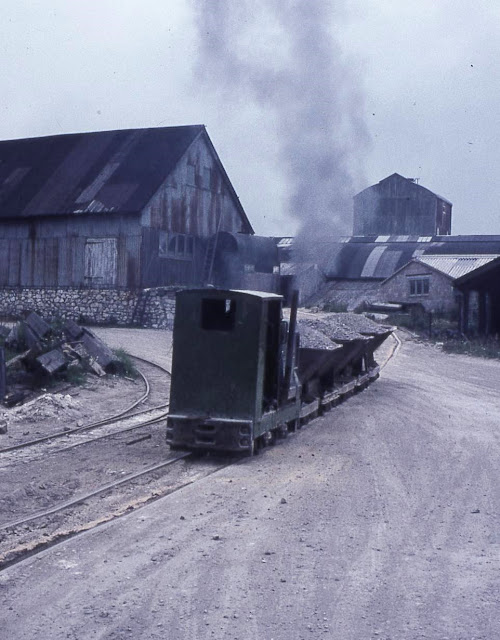Alan Sewell's trips to Derbyshire Silica...
Regular blog reader and contributor Alan Sewell recently shared with me some wonderful photos and a few site visit reports from his collection...
Alan visited the site in both 1969 and a year later in 1970. I've taken the following directly from his material, thank you for sharing this all with us Alan, and for allowing me to document it here on the blog. What is wonderful about these long gone scenes is they echo my own garden railway - as well as the Purbeck clay layouts I've built in 009 - especially East Works. Narrow gauge doesn't just mean North Wales slate!
 |
| Derbyshire Silica, Frieden, 1969. Photo Alan Sewell. |
DERBYSHIRE SILICA FIREBRICK Co Ltd
Frieden Brickworks
Derbyshire
Gauge 2’ 0”
26 July 1969
This is an extensive system, connecting road vehicle tipping docks and stocking areas for fireclay, with the brickworks and including a tramway section alongside a minor road.
Silica sand is also brought in and held in covered storage sheds (sand lofts). All the locos were on the complex of tracks in this area. All were painted a light green. They were SD5 4wD MR 7191/37, 4wD RH 210960/41, 4wD RH237914/46 and 4wD RH 191658/38. The latter coupled to a train of side tip wagons.
17 July 1970
One green 4wD RH at work pulling trains of four side tip wagons from one of the tipping docks to the sand loft up a steep gradient accompanied by much squealing of flanges and copious exhaust smoke. One other RH was parked with a train inside the loft and the MR was also parked but in another part of the loft.
The remaining RH was in use on waste disposal duties. This was now the longest run on the system starting at the waste tipping point at the works, then a short piece of roadside running before leaving the works and heading off along grassy and overgrown track set in farmers’ fields to reach a number of tipping areas. The driver said that formerly there were branches to several mines and pits totalling about ten miles. The train had halted at a junction in the fields. One track which led through a gate and a herd of cows was one such mine branch, but now used occasionally for tipping waste.
 |
| Derbyshire Silica, Frieden 1970. Photo Alan Sewell. |
 |
| Derbyshire Silica, Frieden 1970. Photo Alan Sewell. |
Alan's notes also included a hand drawn sketch of the arrangement...
 |
| Derbyshire Silica illustrative plan by Alan Sewell. |
It strikes me that these sorts of industrial concerns do form perfect subjects for the modeller - and yet, they are so poorly documented. You might find a one off photograph in a collection, on Flickr or in a photo album - but Alan's blend of photography and location sketches means there is enough here to take this straight into a layout design. We should make sure that collections like Alan's are treasured and recognised - I hope you all agree - and I hope in time I can publish more of his material here on the blog - who knows, one day there may be enough for a book?
Until next time, more soon....
Hello there !
ReplyDeleteThank you both for this fine report.
Quite inspiring.
I do look forward to the next then.
Best wishes
Dirk
Hi James - and Dirk
ReplyDeleteGlad you found my notes interesting. DSF was indeed fascinating and I seem to remember I was quite surprised when I came across it, as I was thinking it would be a "simple quarry to tip at the plant" system and not the extensive operation it still was.
Like you James I wish there were maybe less Welsh quarries and more other systems modelled, but I guess the charm of Hunslet 0-4-0ST's is greater for many than Motor Rail "lawnmowers!!!
I enjoyed delving back into my notes to post on your excellent blog. My notes go back over fifty-five years so if I something feels appropriate I may well share some more
Hope you have a good weekend
Best regards
Alan
Thanks both, glad that you’re happy Alan too! I notice a healthy number of reads on this post so it’s definitely proven popular.
ReplyDelete